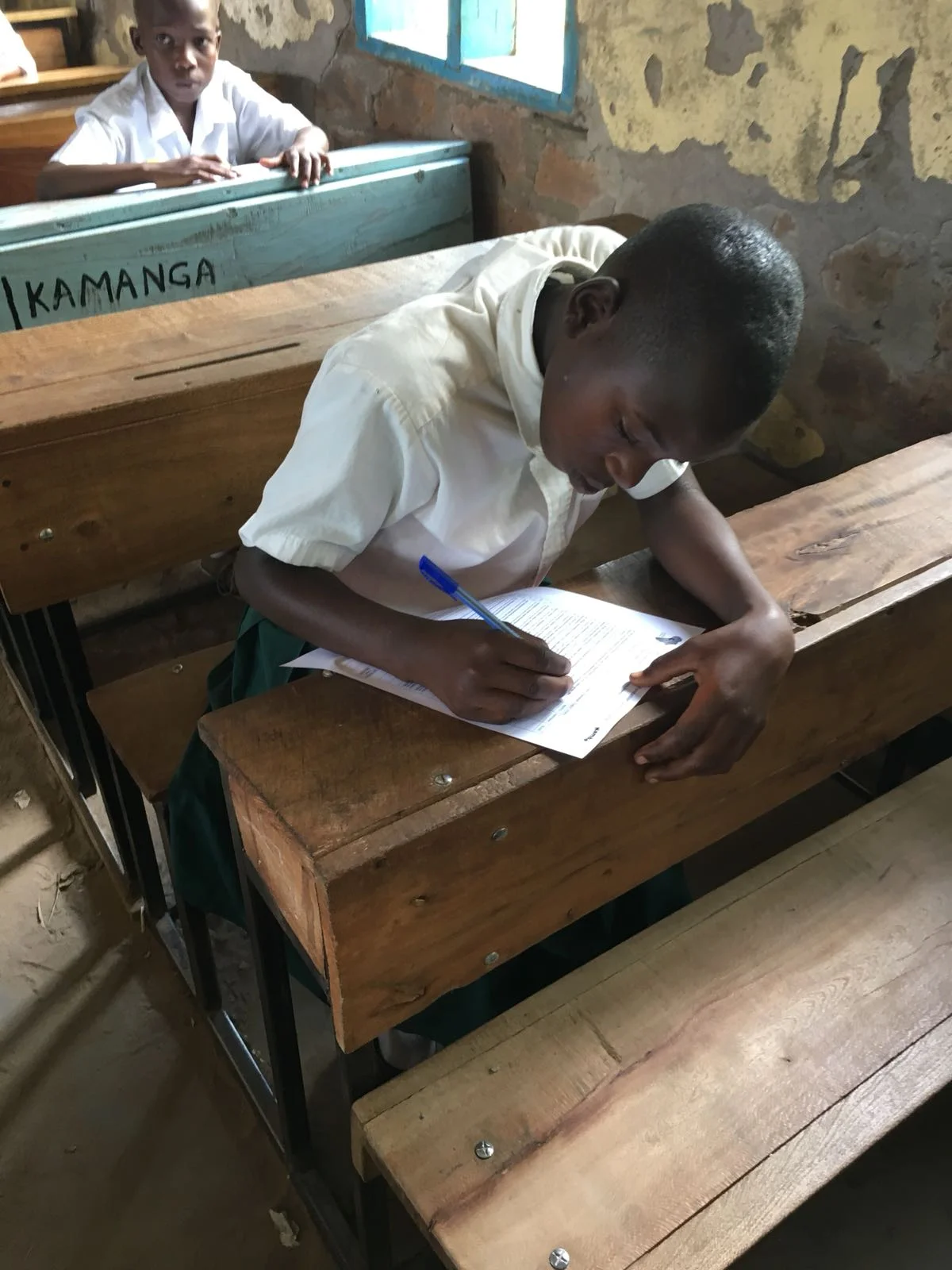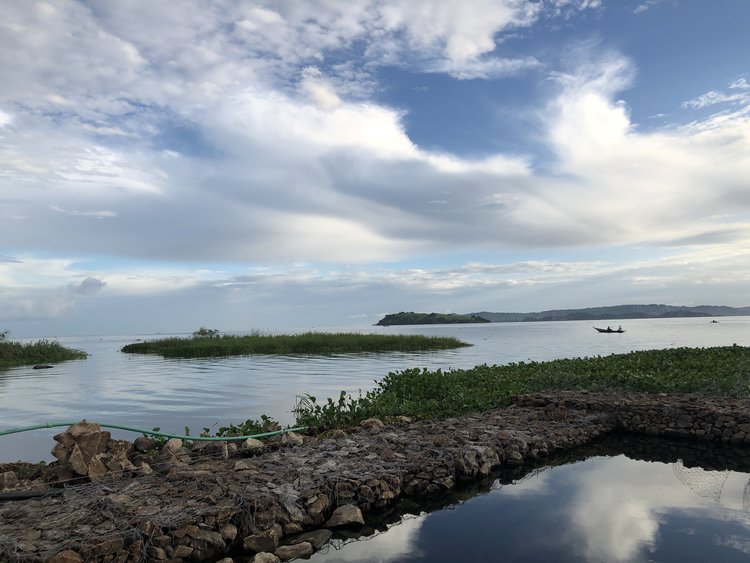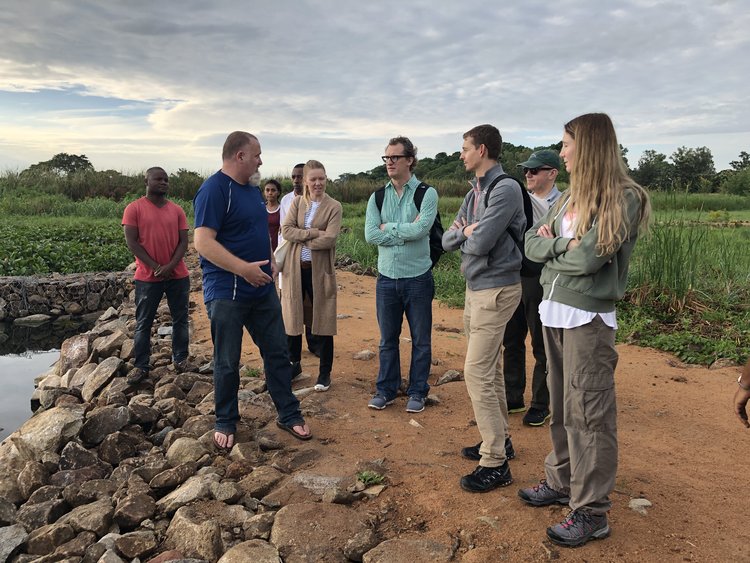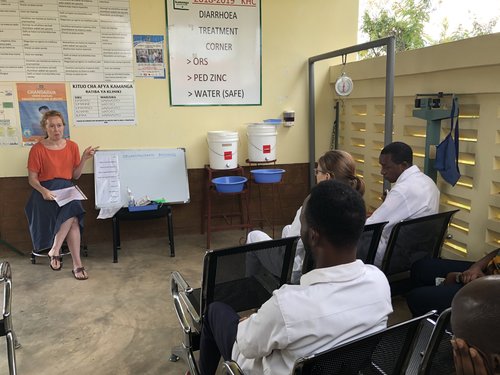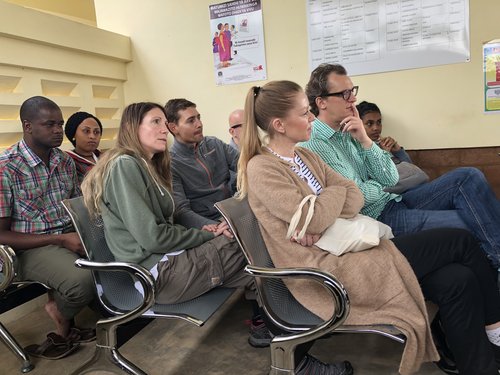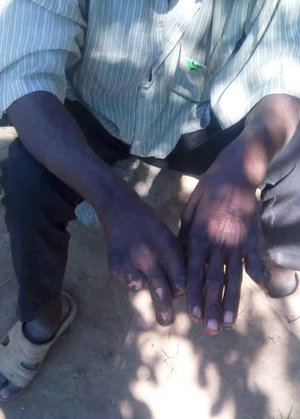Katherine Anne Lee, Chris Eskdale and the rest of Swiss group visiting is being greeted by many happy villagers
It’s still dark as the on-the-ground Cedar Tanzania team picks us up from our hotel in Mwanza. It’s been a short night after flying in from Switzerland, but we have been told that it’s worth catching the first ferry from Mwanza to Kamanga. While driving through the empty streets, I try to study the area to get a first impression of where we are. Now and then we pass someone on foot or a motorbike, loaded to the brim with goods or water. Life starts early in the morning in Tanzania. Moments later, I’m whisked into the organised chaos of the port. It’s fascinating, and at the same time epic, and I cannot imagine how anything works at all here. Large buses, puffing black smoke, push their way onto the old ferry. Women with small children tied to their backs, men with ready-to-sell food supplies and we five Swissies wriggle our way through the little space left on the boat for those on foot. The sun slowly rises as the ferry manoeuvres out of the harbour.
We visitors from Switzerland are not alone on the ferry - the Cedar Tanzania team is with us. Together with the Cedar Tanzania team, we are the only Caucasians on the boat, and you can spot from far who has done this before. Standing there open-mouthed, clinging onto my cotton bag and camera, I’m fascinated, and at the same time worried that the ferry could sink. The chaos that could break out between the black-smoke-puffing buses is unimaginable. It truly is a different world. Feeling a little lost and overwhelmed, I find it best to stick to the group and do whatever they do.
Vivian, Claire, Adam and Dylan from the Cedar Tanzania team are sitting on the back of Mark’s pickup. It seems like a good spot, a little higher up, with some space of my own. We sit together there in the morning and evening, peeling oranges and talking about life, how the team is experiencing Tanzania, their work and what really matters. While sticky orange juice runs down my arm, I can metaphorically see their adventure in front of me and, for a short while, be part of the journey. They are totally dedicated to their work and the journey they are on. They are full of life, and what they are doing is inspirational. I cannot help but wish that I could one day do the same. I look forward to repeating the ferry procedure with them the next day, and to hear more of their tales.
Arriving at the Kamanga Health Centre, we are given a tour of this tranquil place. They have made a great job of building the medical centre. After passing the gates, you enter a true oasis of peace and care. In a country that is not necessarily familiar with western medicine – in many areas, they work with traditional medicine, and we have to be aware that our way of living isn’t necessarily theirs – this is definitely a good basis on which to build trust. During the tour, we do see that there is definitely more we can do. In my last story about Emanuel’s walk, I talked about Lake Victoria and how the lake’s water is poisoning its surroundings. Kamanga Health Centre is on the lake, and depends on its water. Although water-purifying systems are doing their job, more is needed, and projects to filter the water in ponds are in progress. What amazes me is that the fish of Lake Victoria are moving with the water. The natural cleaning system seems to be a good spot for the fish, and this could maybe become an attractive side-line for the centre one day. Another problem we are made aware of is power. The hospital regularly experiences power-outages. Emergency generators can fill the gap, but this solution isn’t compatible with the aims of low costs and sustainability. Ideally, the centre should be powered by solar energy. I think this is a great project idea, and I truly hope it can be started sooner rather than later.
At Kamanga Health Centre, we get to know Sian and Colinda. They are very talented doctors from the UK and the Netherlands, and I don’t know what the centre would do without them. Our group is allowed to join their training session for local medical staff. I have never done anything like this before, and try my best to keep up with the medical terminology. I actually catch myself wishing I could stick around a little longer and support them in their everyday tasks. It’s really fun to learn and be part of the group. They do an amazing job with their teaching, making Cedar Tanzania’s efforts more lasting, with a sustainable outlook. Day by day, the local medical staff can take over more and more of the centre’s tasks.
What impresses me most is how devoted and happy the Cedar Tanzania team is. It’s such a great atmosphere and they all give the impression that they have found profound happiness in what they do. I’ve heard the term “who cares, wins” in a financial business context, but I feel this is also true in the case of the Cedar Tanzania team. If you ever get the chance to visit them, I can only motivate you to do so! My big thank-you goes out to the Cedar Tanzania team. Thank you so much for having me, for showing me your world, for inspiring me. You all do a great job! My third story is about you, because you are on my mind, and you did change my view for the better.
As much as I admire the passion, fearlessness and work of the volunteers on the ground, those back home also help immensely and show passion for good work. I can remember a speech by his holiness the Dalai Lama. He was talking about volunteering to help others. A guest told the Dalai Lama how it makes him feel bad to not be on the ground, helping those in need. He wanted to know if the Dalai Lama would suggest that he should give everything up and travel to a country in need of support. I feel this is a question that bothers many of us. The Dalai Lama reassured his guest by telling him that it would never work out if we were all to give up what we are doing and head out as volunteers. Two kinds of people are necessary in order to keep a healthy system running: those who provide the support on the ground and those who stay home and keep our world working. What is important is that we all do our best, be thoughtful and care, because, ‘who cares, wins’!

